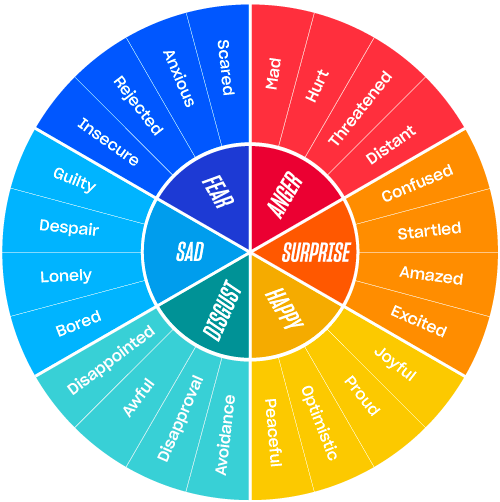What are the feelings, and how different are they from our emotions?
There’s a whole range of feelings that extend beyond the basics. But all feelings have one thing in common: they emerge from a reaction to emotions.
Emotions and feelings are often used synonymously, but they aren’t the same. Knowing how to tell the difference between them as well as getting in tune with them is paramount for your well-being and success.
What Are Feelings?
What is a feeling but simply an emotional experience or a physical sensation? They are our learned reactions to an emotional trigger and determine whether we are happy or sad, content or frustrated, and so on.
For example, you might experience “happiness” through feelings of bliss, exhilaration, or optimism. These are expressions of that particular core emotion, going beyond saying, “I’m happy.”
That’s the purpose of feelings—to be more specific in articulating what you’re experiencing. In fact, the English language has more than 4,000 words that describe feelings.
“Feelings” definition in psychology
Feelings are related to emotions, but they’re not the same. The “feelings” definition in psychology is the response to emotions.
It’s a “self-contained phenomenal experience,” according to the American Psychological Association. They explain this noun as “subjective, evaluative, and independent of the sensations, thoughts, or images evoking them.”
American psychologist R.S. Woodsworth viewed feelings and emotions as representing a person’s inner state, also known as their mood. Then, there’s also Immanuel Kant’s definition of feelings as states of unpleasantness and pleasantness, also known as psychological effects.
Looking at the word’s etymology, “feel” dates back to the Middle English word “fallen,” which means to perceive by touch. However, psychological feelings have more to do with internal than external sensations.
So much so that those feelings can strongly influence your perception of events, with the possibility of harboring bias.
The Differences Between Feelings and Emotions
What are feelings without emotions? Both are often used interchangeably, but they don’t mean the same thing.
So what are the differences between emotions vs. feelings? Here’s a closer look:
- Feelings are how you experience emotions. They’re influenced by a person’s personal beliefs, memories, hormones, and even their environment. Because of this, they may differ from one person to another.
- Emotions typically range from four to eight core emotions. This list includes happiness, surprise, fear, anger, sadness, and disgust.
“Emotion,” according to the psychological definition, is a psychological state that involves subjective, psychological, or behavioral elements. Simply put, it’s how you would deal with positive or negative matters or situations that you find significant.
To put it into context, let’s look at an example. Take, for instance, the animals in a zoo.
Seeing them caged up could stir up the emotion of sadness. The feelings that arise as a response to that could be disappointment that the animals aren’t allowed to roam free or dismay that zoos are even still in existence in this day and age.
In this situation, the stimulus is the same. But where emotion is the foundation, the feelings are a deeper response.
This wheel is a great example of the feelings connected to core emotions.

What Are Examples of Feelings?
Here are examples of feelings linked to common core emotions:
| Core Emotion | Example of Feelings |
| Happiness | You feel joyful, especially when you receive special attention or a thoughtful gift from your significant other. |
| Surprise | You feel shocked or startled, like when someone sneaks up on you. |
| Fear | You feel anxious during stressful times, like when you have to give a presentation at work. |
| Anger | You feel enraged when someone does a fender bender to your car. |
| Sadness | You feel guilty about seeing a homeless person in the street. |
| Disgust | You feel repulsed when you see bugs, especially dead ones. |
Given that more than 4,000 words describe feelings, there are endless examples to choose from. And while this is a dive into feelings, their importance should also be noted.
Why Are Feelings So Important?
The feelings you experience, positive or negative, are there for a reason.
Fear and anxiety may alert you to potential threats and help you respond accordingly. On the other hand, some feelings allow you to have meaningful social interactions and create emotional connections, like empathy, compassion, and understanding.
Here are three research studies that look at the impact of not expressing your feelings:
- One study looked into emotion regulation. Its results showed that suppressing feelings is associated with fewer positive emotions and more negative ones.
- Another study compared participants diagnosed with major depression with healthy controls. Their results found that those who suppressed negative and positive emotions reported increased depressive symptoms and fear of emotions.
- A 2017 meta-analysis investigated the relationships between levels of emotional expression and suppression and social and interpersonal outcomes. Its results suggested that emotion suppression is associated with poorer relationship quality, lower social satisfaction, lower social support, more negative first impressions, and lower social well-being.
The bottom line is that what you feel can help enrich your life. Negative emotions can be a burden, but the positive experiences of our lives would be less meaningful without anything to compare them to.
How to Express Your Feelings: 5 Tips From the Founders of Lifebook
Expressing your feelings can sound scary. After all, it leaves your emotions open to interpretation, and that can leave you feeling vulnerable.
So granted, the follow-up query “What are feelings?” is bound to arise. And that is how to express your feelings.
It’s more than just learning how to control your emotions. Rather, it’s about embracing them and healthily articulating them.
And when it comes down to feelings, Jon and Missy Butcher, trainers of Mindvalley’s Lifebook Online Quest, know a lot about the topic. So much so that one part of their Quest focuses specifically on it.
Here are a few of their tips that can help you express your feelings better:
1. Be gentle with yourself
As you practice feeling your feelings, you’re bound to make mistakes or get frustrated in the process. So it’s important to remember to be gentle with yourself.
Gentleness bolsters care, consideration, and tenderness. It’ll help you be less critical and less judgmental as you practice feeling your feelings.
“There is no shortcut to self-mastery,” Jon explains in the Quest. And for you to master your feelings and emotions, start by being kinder to yourself.
2. Acknowledge the feeling
Your feelings are signals within you, and their purpose is to tell you something. So don’t ignore it.
According to Jon, pleasurable feelings tell you that you’re doing something right and making good choices. And the unpleasant ones? They’re telling you that something’s wrong, that a boundary is being crossed, or even to run.
So take the time to notice the types of emotions that arise and acknowledge the feeling that’s attached to them. This will help you recognize what it is and what to do with it.
3. Name the feeling
Your feelings are forever seeking expression. (That might be why there are so many varieties of them!) So giving it a name can help give it the attention it craves.
One study looked into emotional clarity—naming an emotion or a feeling—and how it’s associated with emotional regulation. The results found that the lack of emotional clarity was linked to symptoms of depression, social anxiety, borderline personality, binge eating, and alcohol use.
It helps to expand your vocabulary and learn new words for different feelings. Ecstatic, elated, excited, thrilled, and blissful are all feelings that fall under the emotion of “happy.” But they all express different spectrums of happiness.
So, as Jon suggests, when you acknowledge your feelings, name them as well. When you’re able to do so, you’ll be able to respond to situations better, which can help enhance your well-being and enrich your connection with others.
4. Use positive self-talk
Your inner voice, or self-talk, combines your conscious thoughts and beliefs. So being aware of how you talk to yourself impacts how you feel and what you do.
When it leans toward the negative, it undermines your confidence and self-esteem, contributing to issues with your overall well-being. However, when your self-talk is positive, it can be supportive and beneficial, motivating you to seek greatness in all areas of your life.
Jon shares, as an example, “When unhappiness comes up in my life, I treat it as an unwelcome imposter.” It’s his version of positive self-talk that works for him.
It’s not so much about tricking yourself into perceiving everything in life as wonderful. Rather, positive self-talk can help you see things as a whole in a calm, rational manner.
5. Be aware of what makes you happy and what doesn’t
While it’s not always possible to control your emotions, you can try to put yourself in situations, events, people, places, and things that evoke good feelings rather than negative ones. For example, if there are certain people whose vibes uplift you, then try to hang out with them more often.
After all, the ultimate goal in life is happiness and fulfillment. So Jon suggests paying attention to what makes you happy and fulfilled versus what makes you unhappy and unfulfilled. That’ll help you react appropriately and create the life you love.

Get in Tune With Your Feelings
So, what are feelings? They’re nothing more than your innate response to emotions. It’s an intricate part of who you are. As the saying goes, “Don’t apologize for feeling something or a lot.”
So if you want to learn how to be at one with them, you can learn from the experts, like Jon and Missy Butcher, at Mindvalley.
In their Lifebook Online Quest, not only will you learn how to be more mindful and aware of what you feel, but when you do, you can better steer the other categories of your life. And ultimately, you’ll be able to rediscover your true self and awaken your unstoppable.
Welcome in.
—
Images generated on Midjourney.









